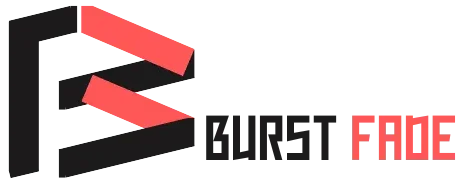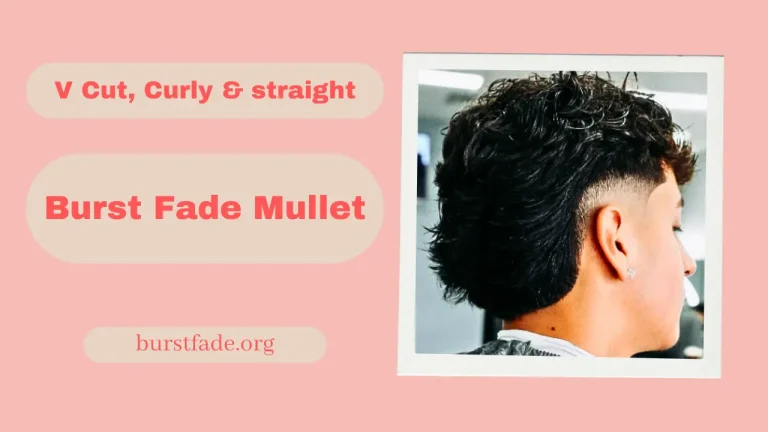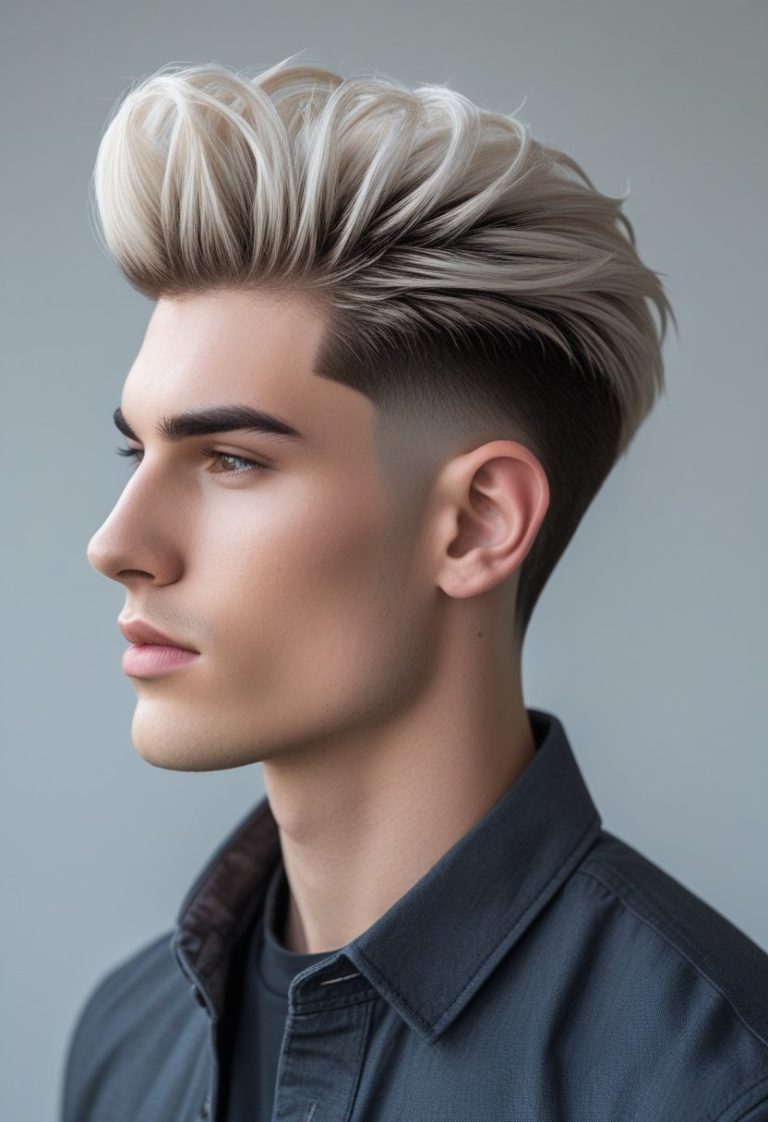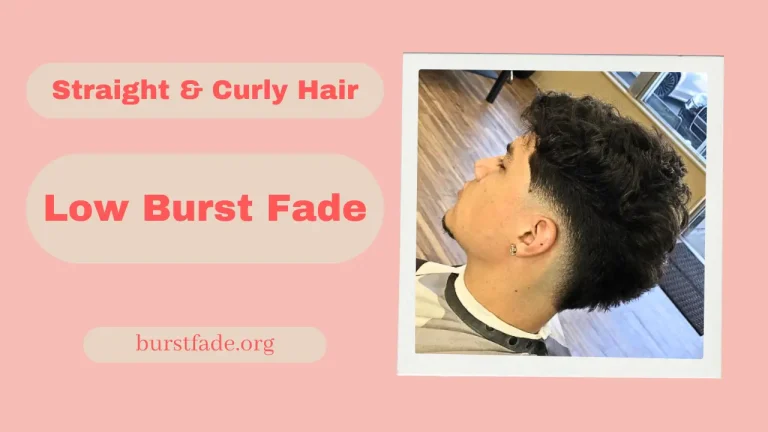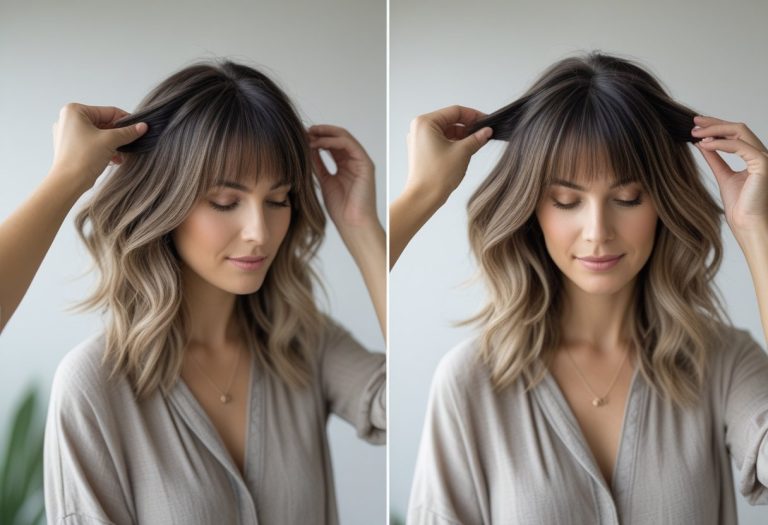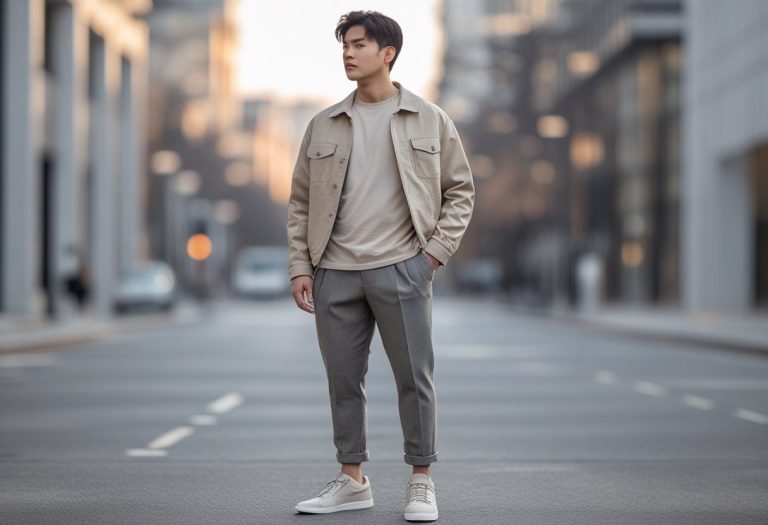Modern Textured Quiff Hairstyle for Men Trends
The modern textured quiff hairstyle for men in 2025 combines natural volume on top with clean fade sides, creating a balanced look that suits various occasions. This style offers a rugged yet refined appearance, making it perfect for those who want to maintain a polished image without appearing overly formal. A well-shaped beard complements the haircut, enhancing the overall masculine aesthetic.
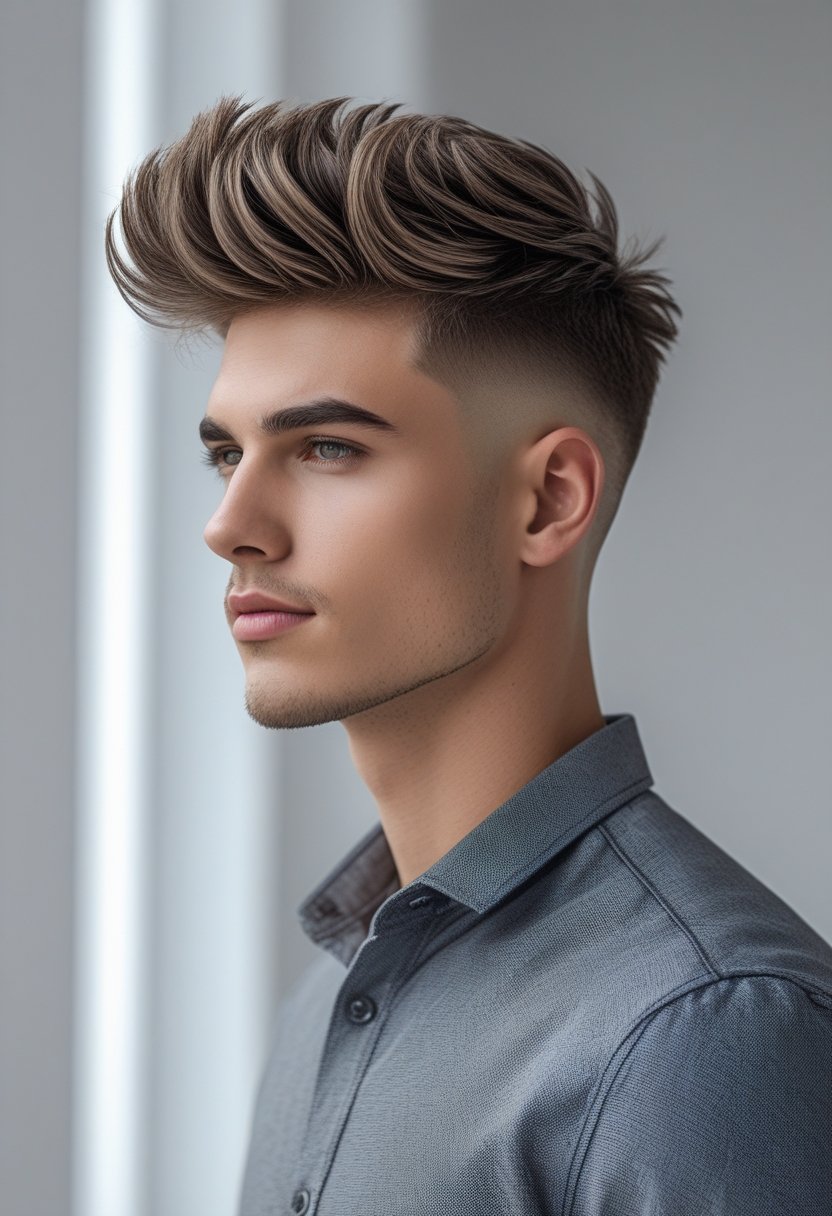
This haircut is versatile enough for both casual settings and smart street style, fitting seamlessly with current fashion trends. Pairing the textured quiff with a red flannel shirt adds a timeless urban lumberjack vibe that has gained popularity in men’s grooming and style circles. It’s a simple way to elevate everyday looks with minimal effort while staying on trend.
Modern Textured Quiff Hairstyle Overview
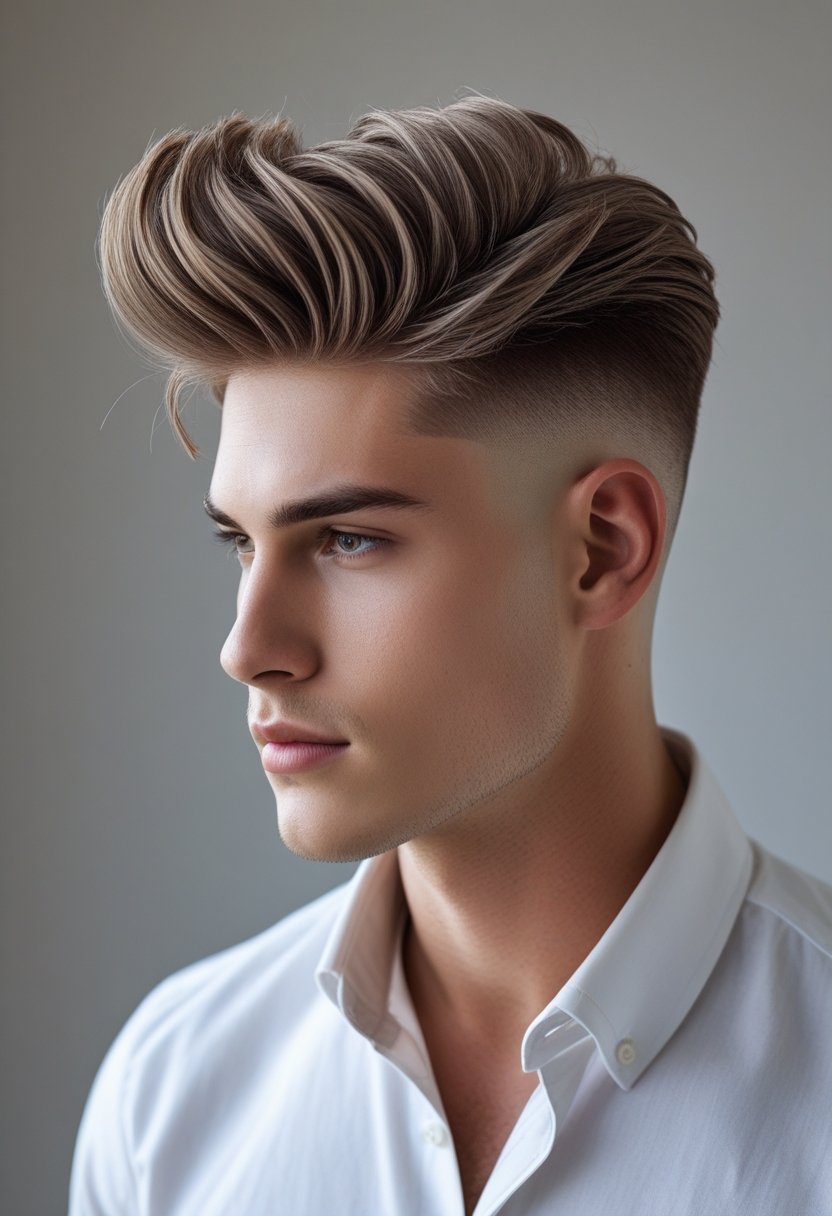
The modern textured quiff stands out by combining volume, texture, and sharp fades. It offers versatility and a polished appearance that suits a variety of face shapes and occasions. This hairstyle balances ruggedness with sophistication, distinguishing it from other men’s haircuts.
Defining the Modern Textured Quiff
The modern textured quiff features hair styled upward and slightly back, creating natural volume and movement. Unlike overly slick or rigid styles, it emphasizes a relaxed yet controlled texture. This effect is achieved by using minimal styling products that enhance definition without weighing hair down.
Typically, the top is left medium length to allow styling flexibility, while the sides and back have a clean precision fade. The hairstyle invites a subtle messy or tousled look, which combines effortlessness with structure. It’s designed for men who want an updated classic with a fresh, masculine edge.
Key Features of the 2025 Quiff
Key elements of the 2025 textured quiff include:
- Natural volume: Hair on top is lifted for height but retains softness, avoiding stiffness.
- Precision fade: The sides and back feature close fades that sharpen the silhouette and keep the focus on the quiff’s texture.
- Versatile styling: The cut supports both sleek, polished finishes and more casual, tousled looks.
- Integration with facial hair: Pairing the quiff with a neatly trimmed beard enhances masculine definition and balances the overall style.
This combination works well for both casual streetwear and more refined settings, making it a flexible option for modern men.
Quiff vs. Classic Hairstyles
Compared to the classic quiff hairstyle, the textured quiff prioritizes a more natural finish and varied movement rather than uniform volume. The classic quiff is often uniformly styled with a smooth pompadour-like lift, while the modern textured quiff uses layers and uneven lengths for dimension.
In contrast to other men’s hairstyles like the slick back or undercut, the textured quiff maintains a balance between volume and edge without becoming overly stylized. It adapts well to straight, wavy, or slightly curly hair, expanding its appeal beyond traditional quiff wearers.
Essential Tools and Hair Products

Creating a textured quiff requires a combination of the right products and tools to build volume, shape, and hold without weighing hair down. Managing natural volume and enhancing texture need targeted styling solutions, while maintaining the fade and beard involves precision grooming tools.
Choosing the Right Styling Products
Matte pomade and styling cream are key for a natural-looking quiff with texture and light to medium hold. Matte pomades avoid shine, giving hair a soft, effortless finish that highlights texture without stiffness.
Volumizing mousse or sea salt spray helps lift hair at the roots and create body. Mousse adds lightweight volume and hold, ideal before blow-drying, while sea salt spray enhances texture through a slightly gritty, lived-in effect.
Wax provides stronger hold and control but can add some shine; it suits thicker or coarse hair for a more defined style. Selecting products with lightweight formulas prevents heaviness, essential for maintaining the quiff’s natural volume.
Important Styling Tools for Volume and Texture
A round brush is crucial for shaping the quiff while blow-drying, allowing precise control over direction and lift at the roots. This tool helps build volume without flattening the hair.
Volumizing shampoo sets a clean base by removing product buildup and enhancing natural body. Using it regularly ensures hair remains light and responsive to styling.
Blow dryers with adjustable heat and airflow settings give control to avoid damage and create structured volume. Combining heat with product application sets the quiff’s shape effectively.
Best Finishing Products for Hold
Hairspray is essential for locking the style in place without overloading the hair. Flexible hold sprays keep the quiff intact while allowing natural movement, avoiding a stiff or crunchy feel.
For a clean finish, lightweight pomades or cream can be used sparingly to tame flyaways and define edges around the fade and beard line.
Final touches with products tailored to his hair type preserve the style throughout the day while ensuring the natural volume and textured effect remain fresh.
How to Achieve the Perfect Textured Quiff
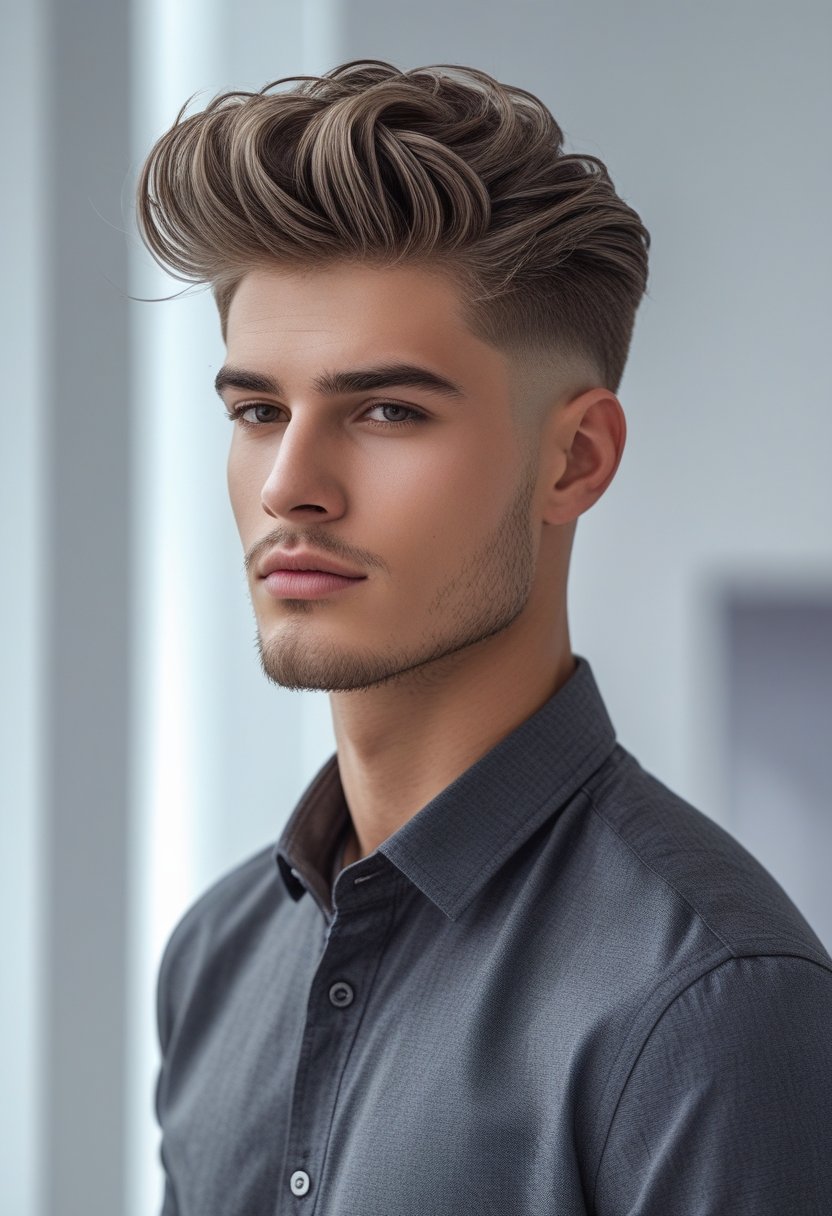
Creating a textured quiff requires attention to hair prep, controlled blow-drying, precise shaping, and the right finishing products. These steps work together to build volume, define texture, and hold the style throughout the day while keeping the modern quiff’s signature clean look.
Prepping Your Hair
Begin with clean, towel-dried hair free from excess moisture but still slightly damp. This helps the hair hold shape better during styling.
Use a lightweight styling cream or volumizing mousse to enhance texture without weighing hair down. Apply evenly from roots to tips, focusing on the top where volume is desired.
Avoid heavy oils or greasy products, as these can flatten the hair and reduce lift. Ensure the sides and back are neatly trimmed with a mid to low fade, providing a sharp contrast to the textured top.
Blow-Drying for Volume
Blow-dry the hair forward initially to build volume in the roots. Use a medium heat setting to prevent damage.
Next, push the hair upward and back using a round brush or vent brush to create height and lift. This technique is essential for establishing the quiff’s signature peak and natural movement.
Dry in sections for more control, especially focusing on the crown for added fullness. Cool air can set the shape once the hair reaches desired dryness and volume.
Texturizing and Shaping Techniques
Work the hair by lightly tousling and dead-lifting strands with fingertips to emphasize separation and natural flow. Use fingers instead of a comb to avoid flattening the texture.
For added ruggedness, consider a matte paste or clay applied sparingly. These products provide flexible hold and allow reshaping throughout the day without stiffness.
Maintain hair length on top between 2-4 inches to balance volume and manageability. The textured quiff thrives on this medium length to exhibit layered detail and motion.
Setting the Style with Finishing Touches
Seal the style with a matte finish product providing medium to strong hold, such as a clay or paste. This avoids shine and creates a modern, natural appearance.
Apply the product evenly, focusing on mid-lengths to ends to define the quiff shape without overloading the roots.
If desired, lightly mist with a flexible hold hairspray for additional durability. Avoid heavy sprays that can create an unnatural, crunchy feel.
Regular beard grooming complements the look, highlighting the hairstyle’s clean fade and structured profile.
Fades, Sides, and Shape: Sides and Beard Integration
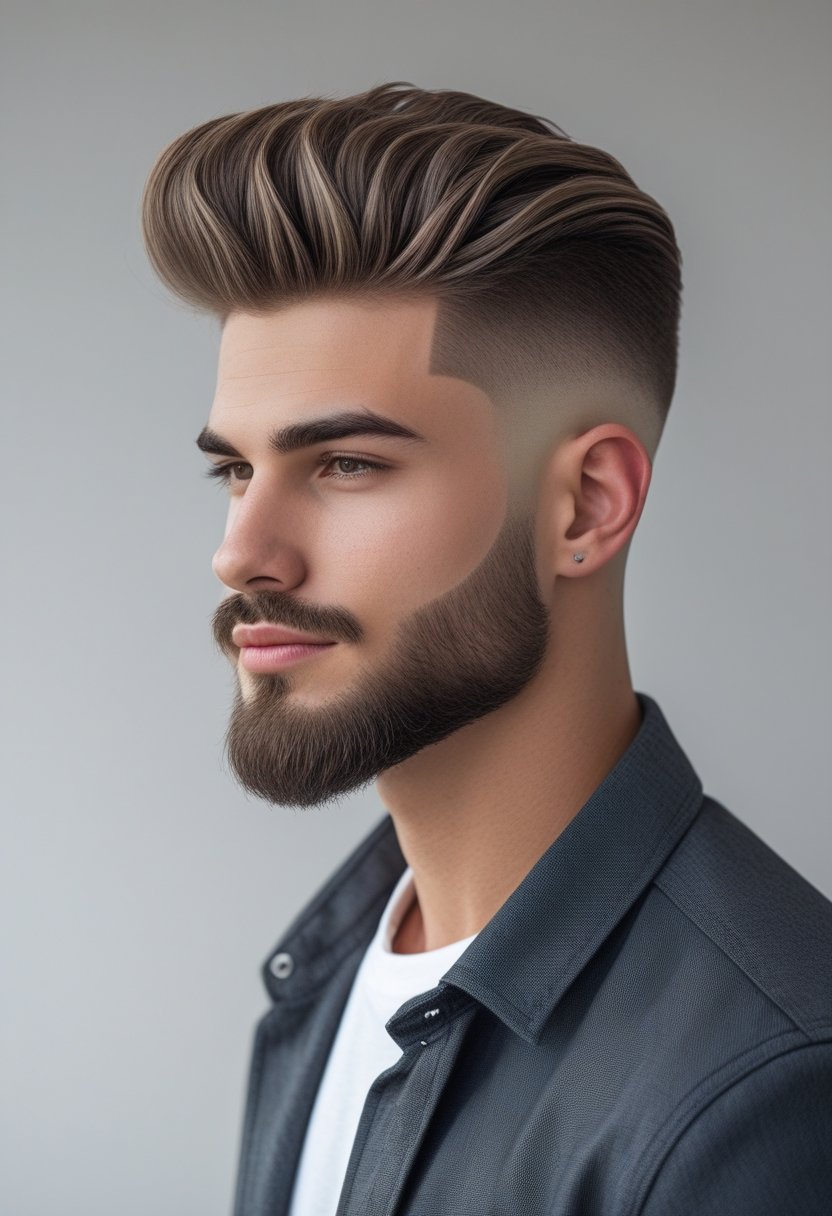
The modern textured quiff shines when its clean fade sides are precisely matched with beard styling. This integration creates a unified and balanced appearance that accentuates facial features. Choosing the right fade type and beard shape emphasizes the hairstyle’s natural volume and sharpens the overall aesthetic.
Understanding Tapered and Fade Sides
Tapered sides gradually shorten the hair from the top down to the neckline, maintaining softness around the edges. This subtle transition blends well with a textured quiff, allowing volume on top to stand out without harsh contrast.
Fade sides offer sharper contrasts in length, with varying degrees from low to skin fade. Fades create a more defined silhouette, emphasizing the hairstyle’s structure. They frame the face and provide a clean, modern look suited to both casual and formal settings.
Both taper and fade techniques complement a quiff, but the choice depends on how bold or understated the person wants the sides to appear. Tapered sides soften the style, while fades make it more striking.
Low Fade, Taper Fade, and Skin Fade Options
A low fade starts just above the ears, offering a gradual and discreet reduction in hair length. It works well to create a subtle frame that highlights the quiff without overpowering it.
A taper fade blends the hair more evenly from the sides to the neckline with a smoother gradient compared to a low fade. It balances texture and volume by creating a neat transition, ideal for men seeking a polished yet natural finish.
The skin fade cuts down to bare skin at the lowest point, producing the most dramatic contrast. It pairs effectively with a quiff for a bold, fashion-forward look. This option requires regular maintenance to keep edges sharp and the fade visible.
Perfectly Shaped Beard Pairing
A tapered beard mirrors the gradual transition found on the sides, increasing harmony between hair and facial hair. It frames the jawline and chin, strengthening the masculine silhouette without drawing attention from the hairstyle.
Short, faded beards create a clean, posh look that pairs well with comb-overs or short undercuts. For longer quiffs, thicker and more textured beards provide balance, preventing the top from appearing too heavy.
Maintaining precise edges on the beard is crucial. Sharpened cheek lines and a defined neckline ensure the beard complements the fade, creating a cohesive and intentional style rather than appearing unkempt.
Adapting the Textured Quiff for Different Face Shapes

The textured quiff offers versatility by balancing volume and structure to enhance various facial features. Adjustments to height, texture, and fade intensity enable a tailored look that complements distinct face shapes while maintaining its modern appeal.
Best Face Shapes for the Modern Quiff
The textured quiff flatters several face shapes, particularly oval, square, and diamond. Oval faces benefit from the added height on top, which maintains their natural symmetry without elongating their proportions excessively. Square faces gain a softened effect as the textured top creates subtle contrast with strong jawlines.
Diamond faces work well with volume that broadens the forehead, balancing narrower chin areas. For round faces, a taller quiff with sharper angles helps elongate the face visually. Conversely, those with long faces should avoid excessive height, opting for more texture and less volume to prevent further lengthening.
| Face Shape | Quiff Adjustment | Goal |
|---|---|---|
| Oval | Moderate volume | Preserve balance |
| Square | Full height, textured top | Soften strong jawline |
| Diamond | Broad volume front | Balance narrow chin |
| Round | High, angular volume | Visually elongate face |
| Long | Lower volume, more texture | Avoid elongating face |
Modifying Volume and Texture for Facial Features
Volume and texture shape the quiff’s impact on the wearer’s facial structure. Individuals with strong cheekbones can opt for heavier texture at the crown, creating dimension without overwhelming the face. Softer texture suits those with finer features, maintaining a natural look that doesn’t appear forced.
Gradual fades on the sides emphasize height and create contrast, but the fade’s intensity should align with face width. Wider faces benefit from a less aggressive fade to maintain balance, while narrower faces can use a skin or mid fade to sharpen contours.
Styling products with matte finishes add natural texture and avoid shine, which can exaggerate facial contours adversely. Adjustable styling helps adapt the quiff from casual tousled to polished sleek, supporting different facial feature highlights across occasions.
Popular Textured Quiff Variations for 2025

Textured quiffs in 2025 come in diverse styles, each tailored to distinct hair types and personal preferences. Men can find versions that range from laid-back, undone looks to sharply styled and high-volume cuts.
Messy Quiff for Effortless Style
The messy quiff emphasizes natural movement and volume, offering a relaxed yet fashionable appearance. Hair is styled with minimal product to enhance texture without a stiff finish.
This version suits men looking for an easy-to-maintain look with a bit of rugged charm. It works best on medium-length hair and pairs well with faded sides to keep the focus on the top. Ideal for casual or smart-casual settings.
Side-Swept and Tousled Quiffs
The side-swept quiff features hair styled predominantly to one side, creating a layered, dynamic effect. Combined with tousled texture, it balances tidy shape with a playful edge.
This cut is versatile enough to suit straight, wavy, or slightly curly hair. It often includes a clean fade to frame the face and enhance the overall silhouette. It’s a refined option for those wanting a polished yet approachable style.
Curly Quiff and Curly Quiff Hairstyle
The curly quiff embraces natural curls, using them to add depth and volume to the look. This variation highlights the texture of curly hair while maintaining the classic quiff shape.
Styling focuses on defining curls without heavy product buildup, preserving softness and bounce. The sides are usually tapered or faded, ensuring a neat contrast. This style is excellent for men with naturally curly or wavy locks seeking a distinctive, textured finish.
Long Quiff and High Volume Variations
Long quiffs extend the hair length on top to create dramatic height and fullness. High volume is a key feature, achieved through blow-drying and styling with volumizing products.
This bold look combines classic techniques with modern edge, making it suitable for those who want a statement hairstyle. The contrast with short, clean-cut sides sharpens the appearance. It adapts well to various hair types but requires more upkeep to maintain shape and volume.
Classic Quiff Reinvented
The classic quiff is updated in 2025 with sharper lines and more textured finishes. It keeps the signature upward and backward sweep but incorporates a modern precision fade and subtle layering.
This reinvention blends traditional masculinity with contemporary trends, balancing neatness with an effortless vibe. It suits almost all face shapes and hair textures, offering a timeless option with a fresh twist.
Styling Inspiration: Outfits and Urban Streetwear

The textured quiff pairs well with various outfits that balance ruggedness and refinement. This style works best when combined with layers, accessories, and color palettes that emphasize urban edge without sacrificing versatility.
Pairing with a Red Flannel Shirt
A red flannel shirt enhances the natural volume of the textured quiff by adding a classic and approachable vibe. The rich hues contrast well with the clean fade on the sides, creating a sharp silhouette.
Wearing the shirt slightly unbuttoned over a plain white or black tee adds dimension and keeps the look casual yet structured. For footwear, opt for leather boots or minimalist sneakers to maintain the urban lumberjack aesthetic.
This outfit highlights masculine confidence and can be worn with rolled-up sleeves to reveal simple accessories like a wristwatch or braided leather bracelet.
Casual and Smart Street Style Combos
For casual outings, the textured quiff suits fitted denim or tapered chinos paired with graphic tees or neutral hoodies. Layer with bomber jackets or lightweight parkas in muted tones for a modern streetwear foundation.
Smart street style incorporates blazers or clean denim jackets alongside tailored trousers. The contrast between the refined pieces and the natural, tousled finish of the quiff creates a balanced look.
Footwear plays a key role: white low-top sneakers or suede loafers add polish without overshadowing the hairstyle’s texture and volume.
Current Men’s Fashion Trends Featuring the Quiff
The quiff trends toward textured, messy finishes that echo the timeless pompadour’s emphasis on volume but with less rigidity. Precision fades and beard grooming complement this style by framing the face sharply.
Contemporary styling favors effortless movement and separation, avoiding overly slick or static looks. Men gravitate toward natural textures supported by lightweight styling products.
This modern quiff fits seamlessly into streetwear trends that blend vintage elements, like 2000s-inspired bags and oversized outerwear, with classic tailoring. It’s a hairstyle that adapts to both casual and upscale urban wardrobes.
Maintenance and Longevity Tips
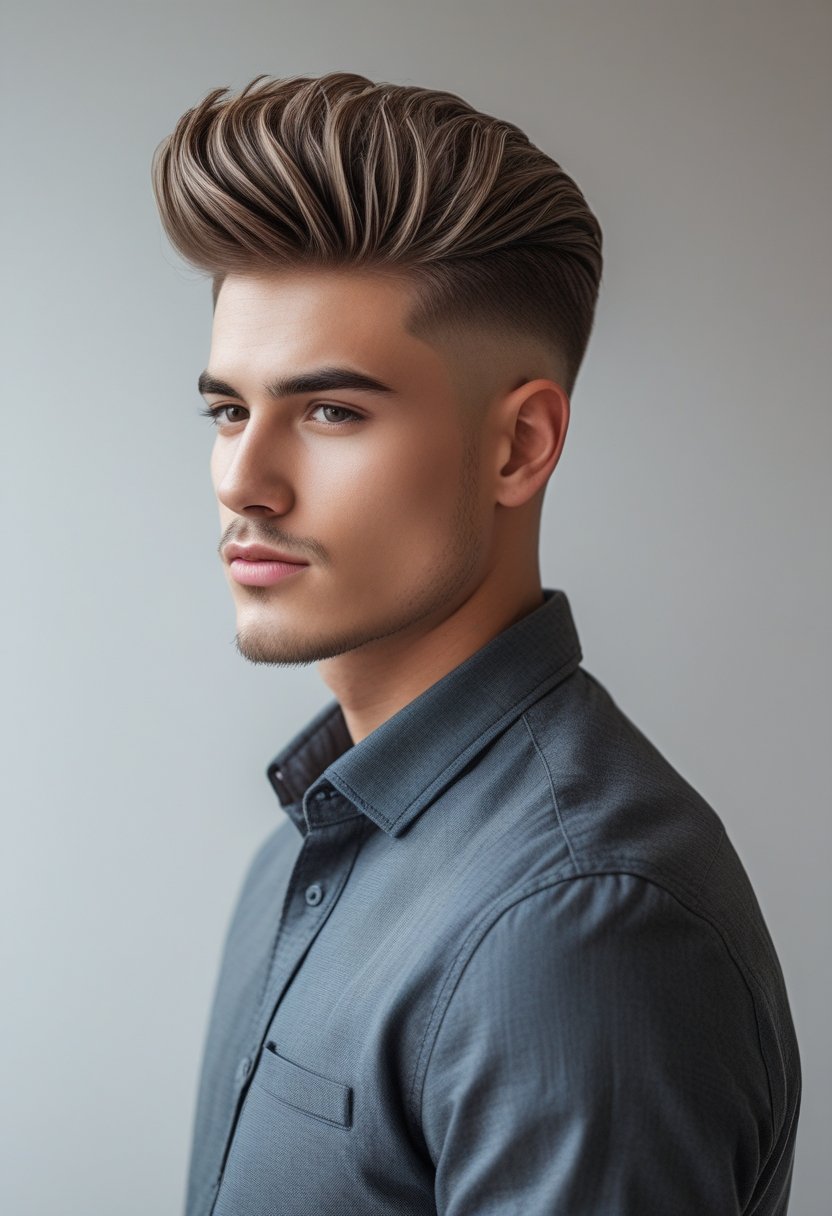
Maintaining the textured quiff involves consistent attention to both hair and beard to keep the style sharp and fresh. Proper daily care, a dedicated weekly routine, and regular shaping appointments ensure the haircut stays well-defined and polished.
Daily Styling and Care
For daily styling, the textured quiff requires using a lightweight matte product to enhance volume and texture without weighing hair down. After towel-drying, hair should be blow-dried upwards and slightly back using a round brush for lift and shape.
A small amount of styling clay or pomade is then distributed evenly through the hair to define the natural waves. Combing should be kept minimal to preserve texture and avoid flattening the quiff’s height.
Regular use of a heat protectant spray before blow-drying helps prevent damage from daily styling. Nightly brushing or combing before bed can help maintain the general hair shape without disrupting texture too much.
Weekly Hair Care Routine
Washing the hair 2-3 times per week with a gentle shampoo preserves natural oils essential for maintaining healthy, textured hair. Overwashing risks drying out the strands, which reduces volume and makes styling more difficult.
Conditioning after shampooing with a lightweight formula adds hydration without heaviness, promoting softness and manageability. A weekly deep conditioning treatment or hair mask supports stronger hair and reduces frizz often associated with this hairstyle.
Scalp care is also important. Massaging the scalp during washing increases blood flow and promotes healthy hair growth.
Maintaining Fade and Beard Shape
Maintaining the clean fade requires trimming every 2-3 weeks to keep the edges crisp and avoid overgrowth. Regular visits to a barber ensure the fade complements the textured quiff’s volume on top.
For the beard, maintaining a perfect shape involves trimming stray hairs and defining clean lines along the cheeks and neck every week. Using a beard oil or balm softens hair and prevents dryness, making shaping easier.
Keeping both the fade and beard in balance preserves the overall refined look, enhancing the rugged yet polished style the quiff haircut demands.
